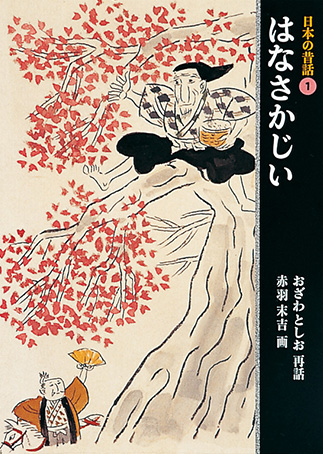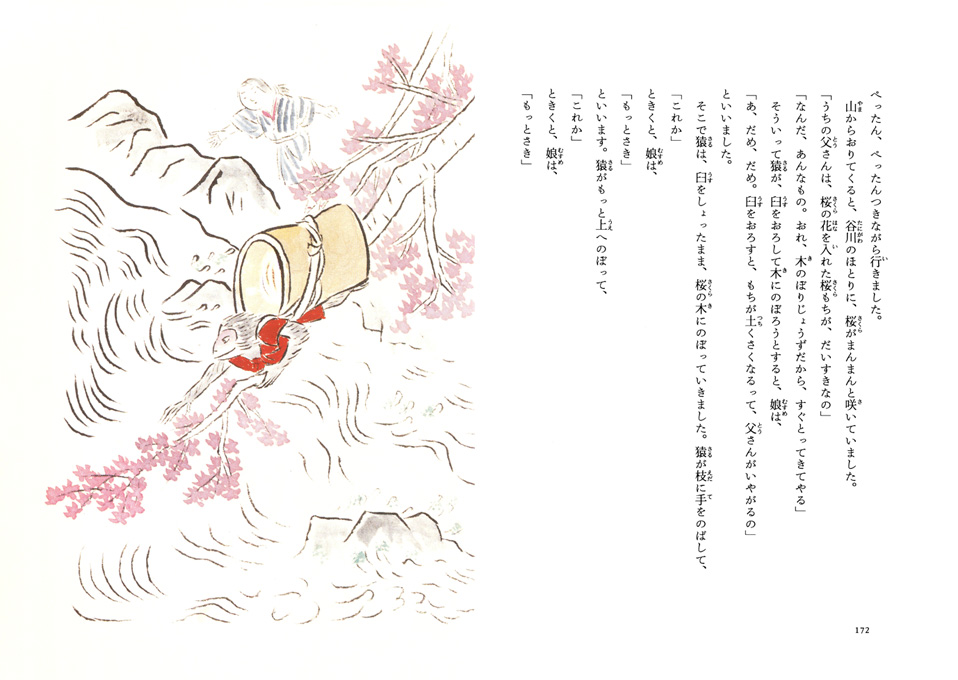“Hanasaka-jii” [trans. The Old Man Who Made Flowers Bloom], in which an honest old man and woman raise a puppy they find in a box floating downriver until one day it leads them to buried treasure (by saying “Dig here, woof woof!”); “Momotarō” [trans. Peach Boy], about a boy born from a peach who leads a dog, a monkey, and a pheasant to fight ogres; “Shitakiri suzume” [trans. The Tongue-cut Sparrow]; “Nezumi no mochitsuki” [The Mice That Pounded Mochi]; “Saru-kani kassen” [trans. The Monkey and the Crab] . . . Japan is home to many folktales, and these five volumes contain 301 of them. The collection is structured to match the flow of Japan’s seasons, from Volume I, with stories evoking New Year’s Day and springtime, to Volume V, with its wintery selection of tales. Collectively, the stories offer a vision of people who grew up and lived in many different ways among the changing seasons, encountering animals and supernatural beings along the way.
The tales were originally recorded in their local dialects, but the author, also a folktale researcher, has retold them using standard Japanese in a way that still allows the reader to grasp their original nature as oral literature. Heroes and enemies are clearly indicated with extreme characterization; events occur three times to leave an impression; and cruel scenes like characters being mutilated and even eaten are expressed frankly, without retailed details. The tales begin with mukashi (“long ago”) but end with traditional closing lines from the local dialect where they were collected, ranging from formulas like iki ga pōn to saketa (“and the family prospered”) and dondo hare (“all was fine”) to partly onomatopoeic expressions like toppin parari no sansho no mi. These phrases have a mysterious ring sure to give today’s children a sense of the appeal of traditional language. At the end of each book are pictures of “implements and tools that appear in folktales” and information about the source for each story. (OM)
The tales were originally recorded in their local dialects, but the author, also a folktale researcher, has retold them using standard Japanese in a way that still allows the reader to grasp their original nature as oral literature. Heroes and enemies are clearly indicated with extreme characterization; events occur three times to leave an impression; and cruel scenes like characters being mutilated and even eaten are expressed frankly, without retailed details. The tales begin with mukashi (“long ago”) but end with traditional closing lines from the local dialect where they were collected, ranging from formulas like iki ga pōn to saketa (“and the family prospered”) and dondo hare (“all was fine”) to partly onomatopoeic expressions like toppin parari no sansho no mi. These phrases have a mysterious ring sure to give today’s children a sense of the appeal of traditional language. At the end of each book are pictures of “implements and tools that appear in folktales” and information about the source for each story. (OM)





